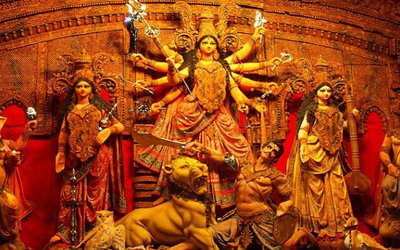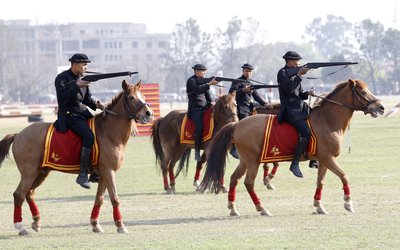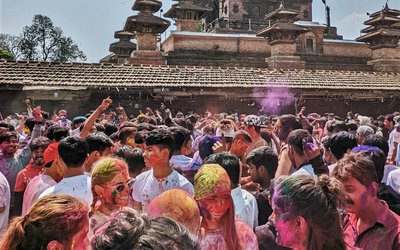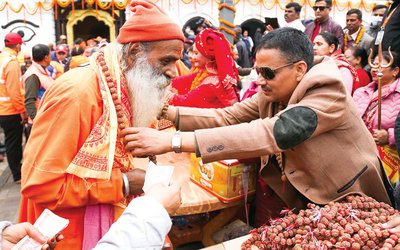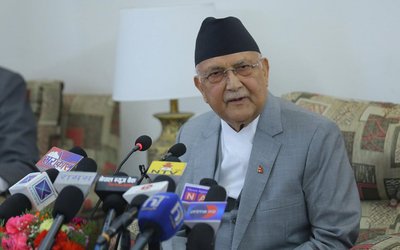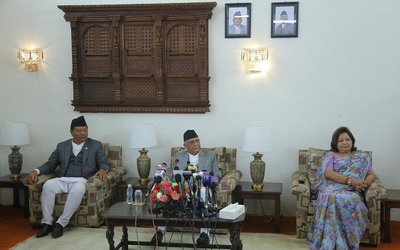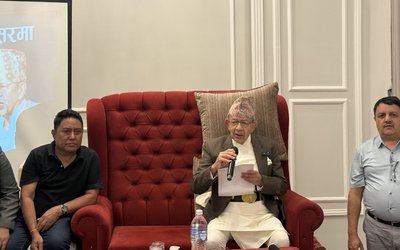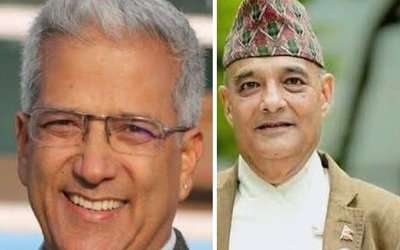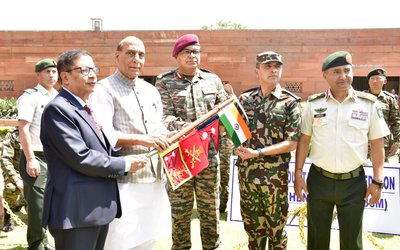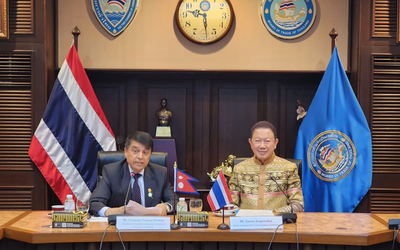
As Mahashivaratri festival is celebrating, which falls today, thousands of devotees, Sadhus and Babas are thronged at Pashupatinath temple area.
Thousands of Shiva devotees from the country and various parts of India are now in Pashupatinath temple and are staying in various locations in and around the temple area.
Thousands of sadhus from Nepal and India come to celebrate the festival of Mahashivaratri by smoking marijuana, smearing their bodies with ash and offering prayers to the Hindu Deity Lord Shiva. Photo: Skanda Gautam
According to Pashupati Area Development Trust, around 5,000 babas are participating in the festival this year, slightly larger in number than the previous years. The PADT office and Guthi Sansthan are responsible for providing food, shelter, firewood to create holy fire called dhuni, and blankets to the babas.
As per tradition, Guthi Sansthan and PADT jointly provide them Rs 200 to Rs 2,000 according to their grades. The babas who come to pay homage to Lord Shiva during Mahashivaratri are provided certain amount of money at a formal farewell ceremony before they return to their own places. Guthi Sansthan claims it provides 5,000 cubic feet firewood for dhuni, which will keep the babas warm during nights.
As the PADT had declared Pashupati area marijuana-free zone stating that it can also check and arrest babas if they are suspected of selling cannabis to visitors, , the number of babas smoking marijuana in the temple area is comparatively low this year than previous years.
Maha Shivaratri is one of the major festivals of Nepal and literally means “Night of the Shiva”. It is celebrated on the 14th day of the dark fortnight of the Māgha month, as per the Hindu lunar calendar.
It is believed that on this day, the stars in the Northern Hemisphere are at most optimum positions to help raise a person’s spiritual energy.It is also believed that the Shiva principle is most active on this day of the year.
A yogi with holy text on his face during the Maha Shivaratri at Pashupatinath Temple in Kathmandu, Nepal.
Maha Shivaratri is celebrated marking the convergence of Shiva and Shakti. Maha Shivaratri also celebrates the night when Lord Shiva performed the "Tandav", the cosmic dance.
Arrangements for Maha Shivaratri
Maha Shivaratri is known as one of the most celebrated religious festivals for Hindus. Every year Hindus from all over the world are seen thronging many Shiva temples during this festival. Pashupatinath Temple is the place with the biggest crowd on this day.
This year, on the occasion of Maha Shivaratri, the Pashupati Area Development Trust (PADT) is expecting a crowd of 2 million people from across the world. For the successful celebration of the festival, the management unit in Pashupatinath have started cleaning the area. Also, this year more importance has been given for figuring out an easier way to manage crowd so that devotees can carry out their Puja and Darshan faster and more conveniently.
Spring is one of the best times to visit Nepal, and Indian tourists enjoy visiting during the most auspicious occasion of Maha Shivaratri. Special provisions are made to ease Darshan for Indian pilgrims at Pashupatinath during Maha Shivaratri.

Photo courtesy: Nepal Tourism Board
Apart from Puja and Darshan other attractions for visitors to the temple vicinity at the time will be the colorful crowd including gorgeous Sadhu Babas from different parts of Nepal and India. People come to Pashupatinath to observe and see the different kinds of Sadhu Babas and their activities; some Sadhus are covered is ashes while some prefer to be completely naked.
MahaShivaratri 2019
Maha Shivratri 2019: Mahashivratri is celebrated by chanting prayers, fasting, and meditating on ethics and virtues such as self-restraint, honesty, forgiveness, and the discovery of Shiva.
Maha Shivaratri 2019: Maha Shivaratri is a Hindu festival celebrated across the country to worship Lord Shiv, also called the "destroyer of evil". Maha Shivaratri is a festival which marks the beginning of spring. This major festival, also known as "the great night of Shiva", celebrates the overcoming of darkness and ignorance.
Maha Shivratri or Mahashivratri is celebrated by chanting prayers, fasting, and meditating on ethics and virtues such as self-restraint, honesty, forgiveness, and the discovery of Shiva. Many devotees stay up all night, while some others visit Shiv temples or go on pilgrimages.
Every year, before the beginning of summer, in the Phalguna month of the Hindu calendar (late winter somewhere in February/March), the 13th night and the 14th day is celebrated as Maha Shivaratri.
While the origin of the festival is not known, legend has it that Maha Shivaratri was the day when Shiv drank poisonous to protect the world. Some believe that Maha Shivaratri is the night when Lord Shiv performs the heavenly dance of creation, preservation and destruction, while others believe that this is the night when Lord Shiv got married to Goddess Parvati.

Last Day For Kumbha
"Maha Shivaratri symbolises the last holy bath of the Kalpvasis and is directly related to Lord Shiva. As per the mythology, this day is awaited in the heavens as well.
Today, the Kumbh Mela in UP's Prayagraj is set to witness the last dip at the Sangam, or the holy confluence of the Ganga, Yamuna and the mythical Saraswati, on the occasion of Maha Shivaratri.
The Kumbh Mela, one of the largest religious gatherings in the world, was held in Uttar Pradesh's Prayagraj from January 15 on Makar Sakranti to March 4 (Maha Shivratri) this year. It is celebrated four times over a course of 12 years.

- India Supported Construction Of Four Schools In Nuwakot
- Mar 19, 2021
- Nepal Denies Permission For Third Phase Trial Of Vaccine Against COVID-19
- Aug 31, 2020
- Messi Can Only Cancel Barcelona Contract If €700 Million Release Clause Is Paid, La Liga Confirms
- Aug 31, 2020
- India To Carry Out Study On Kathmandu-Raksaul Railway
- Aug 28, 2020
- COVID-19: 1,351 Personal Of Nepal Police Infected
- Aug 28, 2020

